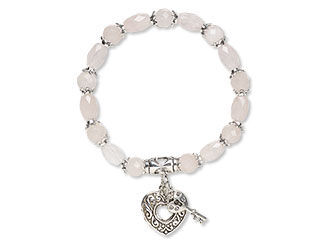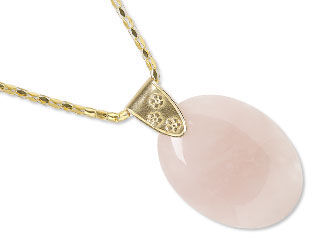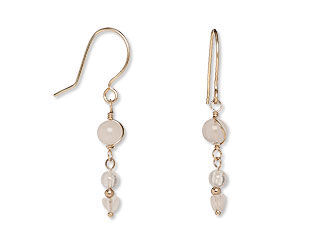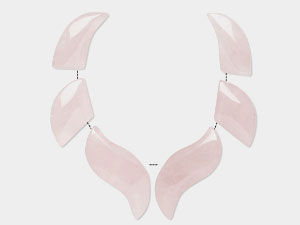Quartz, Rose Meaning and Properties
Rose Quartz History
Rose quartz came to be known as the stone of love and reconciliation from the Greek myth about Aphrodite and Adonis. Their blood was commingled when Aphrodite was cut by a thorn bush while saving Adonis from an attack by Ares (disguised as a wild boar). Their blood stained white quartz to make it a rose-pink color. Later, it became customary for the Romans to use the stone as a gift of love.
What are the Metaphysical Properties of Rose Quartz?
Rose quartz is associated with love, beauty and the heart, and rose quartz’s meaning is thought to be a healing aid for the heart chakra. Imbalances of this chakra have been said to cause colds, allergies and psychosomatic illnesses. When in balance, the heart chakra is thought to make one open to love and compassion. Some believe that rose quartz’s properties include calming effects and helping people develop strong friendships.
What is Rose Quartz Made From?
Quartz includes a large group of minerals based on silicon dioxide. Rose quartz is a macrocrystalline form, as are amethyst, aventurine and citrine. It is a milky pink color, often crackled, and found mainly in large clumps. Only rarely is it found in single crystal form. It is believed that the pink color is due to a small amount of titanium.
Rose quartz is found in pegmatite, a course-grained igneous rock (usually granite). Transparent rose quartz is rare, but is found where the best material comes from: Madagascar. The stone is found in quantity in Brazil, but also is known from Colorado, Scotland and in the former USSR.
- Mineral Information: Microcrystalline quartz
- Chemical Composition: SiO2
- Color: Soft pink
- Hardness: 7 (Mohs)
- Specific Gravity: 2.65
- Refractive Index: 1.544 - 1.553
How Do You Clean Rose Quartz?
With so many of rose quartz’s meanings being associated with love, it is a popular gemstone material for jewelry makers. Rose quartz is fairly hard, so it can be cleaned with an ultrasonic cleaner. Avoid heat with most forms of colorful quartzes to prevent hue shift. Store rose quartz out of direct sunlight to preserve its color.
Rose Quartz - FAQ
Q: Where is rose quartz commonly found?
A: Madagascar, Brazil, Scotland, Colorado and the former USSR
Q: What causes the varying shades of pink in rose quartz and why is the transparency often cloudy?
A: The rose color of rose quartz is believed that the pink color is due to a small amount of titanium in its makeup. Rose quartz has a cloudy (or milky) translucency, caused by a high level of inclusions in the stone.
Q: Is rose quartz rare?
A: Actually, yes! Although quartz is a common mineral, natural pink quartz is a rare version.
Q: How does the cut of rose quartz affect its appearance and energy?
A: The color of rose quartz can be enhanced by its cut. Cabochon and other smooth, curved shapes are favored for this gemstone to showcase and deepen its rosy hues, as well as reveal any asterism (star-shaped inclusion) in a particular piece of gemstone rough. With rose quartz’s meaning being so rooted in matters of the heart, larger pieces with smooth surfaces are believed by practitioners to encourage the smoothing of conflicts in all types of love, not just romantic.
Q: Is rose quartz expensive?
A: Rose quartz is not a particularly expensive gemstone material, although natural (untreated) beads will cost more than dyed or color-enhanced beads of the same grade.
Q: What other gemstones pair well with rose quartz in jewelry designs?
A: Amethyst, amazonite, peridot and clear quartz crystal are popular and attractive pairings for rose quartz designs.
Q: Will rose quartz fade over time?
A: Yes. One of rose quartz’s properties is the delicacy of its color. The pinks will fade over time, especially if exposed to heat or stored in direct sunlight.
Designing with Rose Quartz
Rose quartz is typically a cloudy translucent pink or slightly peach color. The violet of amethyst, either light or dark, is close to pink on the color wheel, and makes for a lovely two-color scheme set in silver. For a beautifully cool split-complementary color scheme, match rose quartz with grass-green peridot and frosty blue-green amazonite. For a light and airy look, mix rose quartz with sparkling clear quartz.
A Few Design Inspirations to Get You Started
Create your own stunning pair of rose quartz earrings using luxurious rose gold-filled components and wire for a soft, feminine touch. In this easy-to-follow tutorial, you'll learn how to enhance teardrop focal beads with beading wire, adding a beautiful and elegant finish to your handmade jewelry.

Shop for Rose Quartz
**Please note that all metaphysical or healing properties listed are collected from various sources. This information is offered as a service and not meant to treat medical conditions. Fire Mountain Gems and Beads® does not guarantee the validity of any of these statements.
How did you like this resource? Your feedback helps us provide resources that matter to you most.
Copyright Permissions
All works of authorship (articles, videos, tutorials and other creative works) are from the Fire Mountain Gems and Beads® Collection, and permission to copy is granted for non-commercial educational purposes only. All other reproduction requires written permission. For more information, please email copyrightpermission@firemtn.com.







